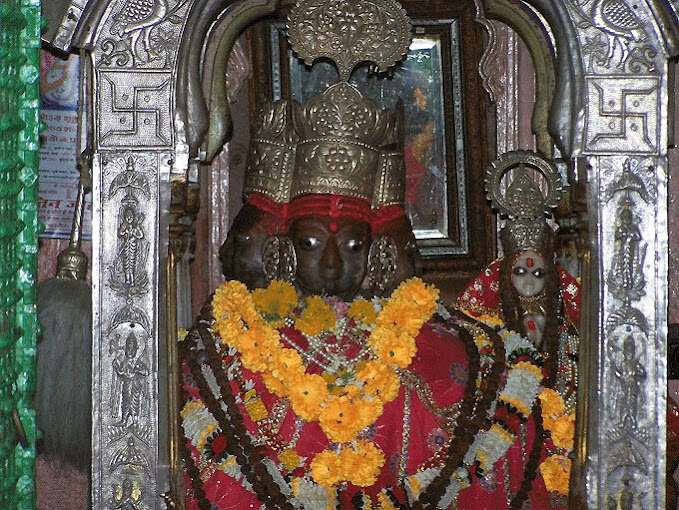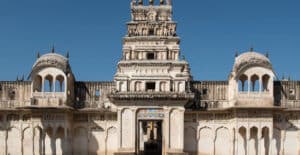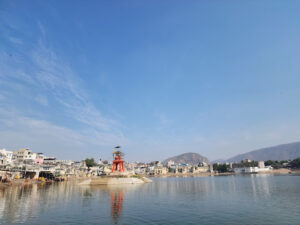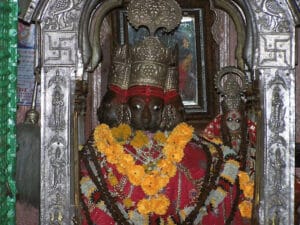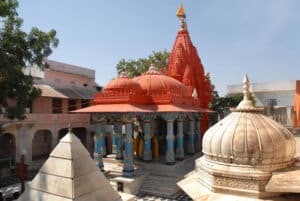Brahma Temple – Pushkar, Rajasthan:
Brahma Temple, Pushkar (also known as Jagatpita Brahma Mandir) is a Hindu temple in Pushkar, Rajasthan, India, near the famed Pushkar Lake, to which its tale is inextricably linked.
The temple is one of only a handful temples in India dedicated to the Hindu creator-god Brahma, and it is the most prominent of them.The pushkar temple edifice was built in the 14th century and was later partially rebuilt. The temple is constructed from marble and stone slabs. It is distinguished by a red pinnacle (shikhara) and a hamsa bird symbol. The sanctum sanctorum of the temple houses an image of the four-headed Brahma and his consort Gayatri (the goddess of the Vedas). The Sanyasi (ascetic) sect priesthood governs the temple.A celebration devoted to Brahma is conducted on Kartik Poornima, when a huge number of pilgrims visit the temple after washing in the sacred lake.
Brahma Temple Pushkar History:
Pushkar is said to have over 500 temples, many of which were destroyed or desecrated by Muslim depredations during the reign of Mughal emperor Aurangzeb (1658-1707), but were later rebuilt; the most important of Pushkar’s temples is the Brahma temple, which dates from the 14th century.The sage Vishwamitra is reported to have built the temple after Brahma’s yagna (ritual). It is also believed that Brahma chose the site for his temple. The pushkar mandir was repaired by the Hindu philosopher Adi Shankara in the eighth century, and the existing mediaeval construction dates to Maharaja Jawat Raj of Ratlam, who performed expansions and repairs while retaining the original temple plan.
Pushkar is frequently characterised in the scriptures as the only Brahma temple in the world, as a result of Savitri’s (Saraswati’s) curse, and as the “King of Hindu sacred places.” Although the Pushkar temple is no longer the only temple dedicated to Brahma, it is still one of the very few remaining temples in India dedicated to Brahma and the most notable among them. Pushkar Lake and the Brahma Temple were named one of the ten most religious towns in the world and one of the five holiest pilgrimage sites for Hindus in India in an article published in the International Business Times.
Legend of the Temple:
According to the Hindu scripture Padma Purana, Brahma witnessed the demon Vajranabha pestering people and attempting to harm his children. He instantly dispatched the demon with his lotus-flower weapon. The lotus petals fell to the ground in three spots throughout this procedure, forming three lakes: Pushkar Lake (Jyeshta Pushkar), Madya Pushkar Lake, and Kanishta Pushkar Lake.
Brahma then chose to perform a yajna at Pushkar’s main lake. To perform his yajna without being assailed by demons, he built the hills surrounding Pushkar — Ratnagiri in the south, Nilgiri in the north, Sanchoora in the west, and Surya Giri in the east — and placed gods there to defend the yajna performance. However, at the yajna, his wife Savitri was unable to execute the vital part of the yajna because she was waiting for her companion goddesses Lakshmi, Parvati, and Indrani. So Brahma married Gayatri, a Gurjar girl, and finished the yajna with his new consort sitting by him, holding the amrita pot on her head and administering ahuti.
When Savitri arrived at the venue, she discovered Gayatri seated next to Brahma, which was her due spot. She cursed Brahma that he would never be worshipped, but eventually lowered the curse to allow his adoration in Pushkar. Savitri also cursed Indra with being easily vanquished in battle, Vishnu with being separated from his bride as a human, the fire-god Agni, who was offered the yajna, with being all-devouring, and the priests officiating the yajna with being destitute.
Gayatri, endowed with yajna powers, mitigated Savitri’s curse, blessing Pushkar to be the king of pilgrimages, Indra to constantly keep his heaven, Vishnu to be born as the human Rama and finally join with his spouse, and the priests to become academics and venerated. As a result, the Pushkar temple is considered the only temple devoted to Brahma. Savitri then moved into Ratnagiri hill and became a part of it by erupting as a spring known as the Savitri Jharna, where a temple in her honour currently stands.
Brahma Temple Architecture:
The temple, which stands on a high pedestal, is entered via a series of marble steps that lead to an entrance gate archway with pillared canopies. The gate leads to a pillared outdoor hall (Mandapa), followed by the sanctum sanctorum (Garbhagriha). The temple is made of stone slabs and blocks that are welded together with molten lead. The temple’s scarlet shikara (spire) and the emblem of a hamsa – Brahma’s mount – are distinguishing elements. The shikara stands about 70 feet tall. The main entry gate is adorned with the hamsa motif. As a mark of their offering to Brahma, devotees inlaid hundreds of silver coins (with their names etched) into the marble floor (in black and white checks) and walls inside the temple. A silver turtle is presented on the floor of the temple facing the Garbhagriha, which is also constructed of marble. The marble flooring has been replaced on occasion.
Brahma’s principal icon (murti) is made of marble and was deified by Adi Shankara in the garbhagriha in 718 AD. The icon represents Brahma seated with his legs crossed in the aspect of universe creation (the Vishvakarma form). The chaumurti (“four-faced idol”) is the focal image. It is life-sized, with four hands and four faces, each pointing in a different cardinal direction. The four arms support the akshamala, pustaka, kurka, and kamandalu. Brahma is riding his hamsa, his mount. Brahma’s four symbols (the rosary, Kamandalu, book, and sacrificial tool kusha grass) symbolise time, the causative waters from whence the universe began, knowledge, and the system of sacrifices to be used for the sustenance of various life-forms in the universe. Gayatri’s image lies in the centre, to his left, alongside Brahma’s. Sarasvati, along with other Hindu pantheon deities, sits to Brahma’s right. The temple walls are also adorned with images of Sarasvati’s mount, the peacock. The temple also has images of the preserver-god Vishnu, life-sized dvarapalas, and a gilded Garuda (eagle-man, Vishnu’s steed).
Brahma Temple Timings:
The temple is open for worship from 6:30 a.m. to 8:30 p.m. in the winter and 6:00 a.m. to 9:00 p.m. in the summer, with an afternoon break between 1:30 p.m. and 3:00 p.m.The temple hosts three artis: Sandhya aarti in the evening, about 40 minutes after sunset, Ratri Shayan arti, about 5 hours after sunset, and Mangala arti, about 2 hours before sunrise.
Festivals at Brahma Temple:
A religious festival in Brahma’s honour is observed once a year on Kartik Poornima, the full moon night of the Hindu lunar month of Kartik (October – November). Thousands of visitors visit the shrine to wash in the famous Pushkar Lake. During the fair, certain rites are also performed at the temple. The day also coincides with the famed Pushkar Camel Fair, which is held nearby. On all poornimas and amavasyas (new moon days), special rites are done.
The priests at the Brahma temple pushkar follow a rigid religious practice schedule. Only ascetics are permitted to enter the sanctum sanctorum to worship the deity; householders (married males) are not. As a result, all pilgrim contributions are made through a sanyasi priest from the temple’s outside hall. The priests of the temple, in general, come from the Parashar gotra .
How to reach Brahma Mandir Pushkar:
The Brahma Temple is easily accessible by regular buses or taxis from any place in Rajasthan.
Pushkar Temple Location:
Brahma Temple Rd, Ganahera,
Pushkar, Rajasthan 305022
Other famous places to visit in pushkar:
Pushkar Place
Pushkar Lake
Savitri Temple
Saraswati Temple
Apteshwar temple
Man Mahal Pushkar
Brahma Pushkar Temple Photos:

